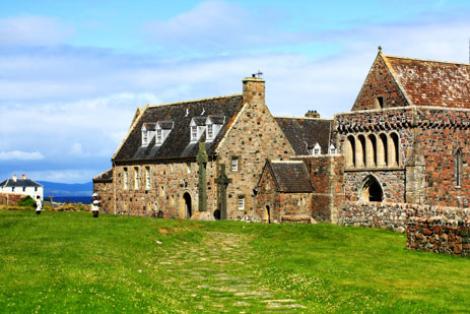
He was a great man, your Patron,” the man on the bus said when the Sister told him she was a Columban missionary. “Yes, he was,” she smiled, delighted that he would know about the sixth century saint whose missionary heart had led him through Europe of which he is now one of the Patrons.
“Yes,” the man continued, “I was very taken with Iona when I visited there years ago. A wonderful spirit in the place. What a holy man he was and what a tough life he and his monks must have had on that little island. And to think that his spirit still flourishes today! You must feel very proud to be one of his followers,” he said with admiration.
The rest of the journey was spent discussing the difference the letter ‘n’ makes. Columba/Columban. Drop it and we have the saint of Iona. Add it and we have the saint who travelled from Bangor to Bobbio. Sometimes, as with the traveller, people get confused. Both were Irish monks of the sixth century, both of noble families, both founded churches and built monasteries. Voluntary exiles from their beloved native land, they were full of love for God and His Word, and missionaries to their core.
It is unlikely that they ever met. Columban travelled across Europe where he is widely venerated today; he died in 613 in Bobbio, in northern Italy. Columba, or Colmcille as he is more frequently called, stayed most of his life in Scotland and is one of the Patrons of Ireland with Patrick and Brigid. He died in 597 in Iona.
Columba of Iona was a man who loved books. Legend has it that when he was visiting St Finnian of Clonard, under whom he had studied, he discovered a manuscript of the psalms and secretly began to copy it. When Finnian heard of this he argued that the transcript belonged to him as he had not given permission for it to be copied. Columba would have none of it; the case went before the High King of Ireland who found in favour of Finnian in the famous judgement, (possibly one of the oldest references to the idea of copyright in history): “To every cow its calf, to every book its copy.”
On this tiny and beautiful island off the west coast of Scotland he established a monastery in 563, where he spent the rest of his life in prayer, study and fasting. He and his monks played a vital role in the evangelization of Scotland and northern England.
After blessing the island and his brethren, this holy man died in the Church in Iona early on June 9, 597. His feastday is celebrated on this date.
Sr Redempta Twomey is Assistant Editor of the Far East, Ireland.
Read more from The Far East, August 2010